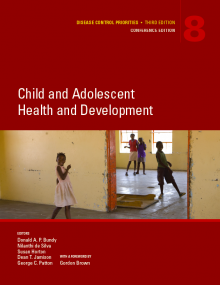Dear Subscribers,
Apologies for the silence, The Lancet Commission on Adolescent Health and Wellbeing, is in a planning phase for the “Lancet Standing Commission”. Stayed tuned – more to come in early 2018!
In the mean time, read below for an important event from our partners in Global Adolescent Health.
DCP3 Volume 8 ‘Child and Adolescent Health and Development’ launch
Disease Control Priorities, 3rd Edition (DCP3) has been a 5 year collaborative effort involving more than 30 editors and more than 500 authors, many of whom you will know. Volume 8 of the 9-volume series is entitled Child and Adolescent Health and Development, and explores the role of health in the development of human capital in poor countries. Further information on DCP3 and Volume 8, can be found here.
Key messages
- It takes some 8000 days for a child to develop into an adult. Sensitive phases shape development throughout this period, and age-appropriate and condition-specific support is required throughout if a child is to achieve full potential as an adult.
- Investment in health during the first 1000 days is widely recognised as a high priority, but investments are often neglected in the following 7000 days of middle childhood and adolescence. This neglect is also reflected in the investment in research on these age groups.
- At least three phases are crucial to health and development during the next 7000 days, each requiring a condition-specific and age-specific response: middle childhood growth and consolidation phase (5–9 years) when infection and malnutrition remain key constraints on development, and mortality rates are higher than previously realised; adolescent growth spurt (10–14 years) when body mass increases rapidly and substantial physiological and behavioural changes associated with puberty occur; and adolescent growth and consolidation phase (15–19 years), which brings further brain restructuring, linked with exploration, experimentation, and initiation of behaviours that are lifelong determinants of health.
- Broadening of investment in human development to include scalable interventions during the next 7000 days can be achieved cost-effectively. Two essential packages were identified: the first package addresses the needs in middle childhood and early adolescence through a school-based approach; the second focuses on older adolescents (15–19 years) through a mixed approach also involving the community, media and health systems. Both packages offer high cost-effectiveness and benefit-cost ratios.
- Well designed health interventions in middle childhood and adolescence can leverage the current substantial investment in education, and improved design of educational programmes can improve health. The potential synergy between health and education is undervalued and the returns on co-investment are rarely optimised.
It is wonderful that many of the LancetYouth Commissioners were able to contribute to DCP3 Volume 8 – relevant chapters below.
1. Child and Adolescent Health and Development: Realizing Neglected Potential: Donald A. P. Bundy, Nilanthi de Silva, Susan Horton, George C. Patton, Linda Schultz, and Dean T. Jamison
5. Global Measures of Health Risks and Disease Burden in Adolescents: George C. Patton, Peter Azzopardi, Elissa Kennedy, Carolyn Coffey, and Ali Mokdad LINK
9. Puberty, Developmental Processes, and Health Interventions: Russell M. Viner, Nicholas B. Allen, and George C. Patton
11. Nutrition in Middle Childhood and Adolescence: Zohra Lassi, Anoosh Moin, and Zulfiqar Bhutta
18. Health and Disease in Adolescence: Nicola Reavley, George C. Patton, Susan M. Sawyer, Elissa Kennedy, and Peter Azzopardi
21. Platforms for Delivering Adolescent Health Actions: Susan M. Sawyer, Nicola Reavley, Chris Bonell, and George C. Patton
26. Identifying an Essential Package for Adolescent Health: Economic Analysis: Susan Horton, Elia De la Cruz Toledo, Jacqueline Mahon, John Santelli, and Jane Waldfogel

